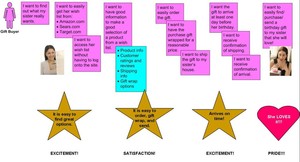The Emotional Rollercoaster within Customer Scenarios
Most Customer Scenarios Bring Out Mixed Customer Emotions; Are You Prepared to Respond to Them?
It’s important to not only understand what your customers want to achieve in their scenarios, but also the emotions they feel and what might trigger those emotions. Too often, companies design for the “happy path” in a scenario. Realistically, however, paths aren’t that smooth and result in a mixture of emotions, both positive and negative. We look at common customer emotions and the opportunities your company can take to “turn that frown upside down.”
NETTING IT OUT
When we describe customer scenarios, we talk about the steps the customers are happy to take to achieve their desired outcomes. Emotion is a built-in consideration. But the reality is that customers undergo a mix of emotions in almost any scenario—even in the most flawlessly executed scenarios. Customers usually experience a mixture of positive emotions—e.g., satisfaction, excitement—and negative emotions—e.g., frustration, anger, anxiety in the course of any particular scenario.
It’s important to not only understand what your customers want to achieve in their scenarios, but also what context they are, in because this often impacts their emotions. A factory manager who needs to do scheduled maintenance on a standby piece of equipment is in a different context than that same manager whose manufacturing line is down because of broken equipment. The botched maintenance scenario might make the manager annoyed and frustrated; failure to get the manufacturing line back up quickly can cause anxiety, anger, and even fear that deadlines won’t be met and her job might be in jeopardy
Understanding and responding to underlying emotions as your customers traverse their scenarios with your company can help you better avoid negative emotions and turn positive emotions into loyal relationships.
Happy Path
© 2012 Patricia Seybold Group Inc.
1. In a perfect world, all steps go as anticipated, and the customer experiences only positive emotions while moving towards the desired scenario outcome.
EMOTIONS ARE INHERENT IN CUSTOMER SCENARIOS
When customers do business with you, they are in the context of a customer scenario—they are trying to achieve a goal, whether it is to:
- Buy a gift that the recipient will love
- Upgrade a telephone system that will easily handle increased call volume
- Obtain a needed prescription to combat an ailment
- Get an emergency repair to a key piece of equipment so the production line will keep moving
We emphasize the importance of understanding your customers’ scenarios and their desired outcomes—the ultimate goals. But it is not enough just to understand what customers—who are people, just like you, whether consumers or business customers—want to achieve; you need to be aware of how they are feeling while they are in the context of the scenario.
Different Emotions at Different Steps of the Scenario
As customers traverse the steps of the scenario leading to their goal, they might have a single emotion throughout: for example, when buying the perfect gift, they may be excited from the first foray into the shopping experience through the joyful reaction of the recipient. However, this “happy path” scenario (see Illustration 1) is uncommon. Let’s break down the steps of the scenario and look at possible changes in customer emotion along the way as things might go wrong (see Illustration 2).
Happy and Unhappy Paths through a Scenario
Download the PDF to see the table.
Table A. When a scenario goes well, positive emotions result. But when there are problems, the negative emotions that surface can sour even the best of customer relationships.
Context Impacts Emotions
The reality is that customers undergo a mix of emotions in almost any scenario. The more complex, and more “important,” the scenario, the more likely a less than stellar experience will yield negative emotions. Nancy’s scenario, laid out in the illustrations and table A, while important to her, isn’t life altering. If she misses getting a gift to Christine in time, it probably won’t negatively affect her life in the long run. But let’s consider some of the other scenarios mentioned earlier...
Sign in to download the full article
0 comments
Be the first one to comment.




